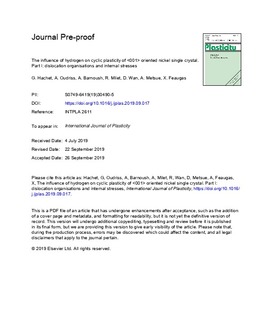| dc.contributor.author | Hachet, G | |
| dc.contributor.author | Oudriss, A | |
| dc.contributor.author | Barnoush, Afrooz | |
| dc.contributor.author | Milet, R | |
| dc.contributor.author | Wan, Di | |
| dc.contributor.author | Metsue, A | |
| dc.contributor.author | Feaugas, X | |
| dc.date.accessioned | 2020-01-31T14:12:16Z | |
| dc.date.available | 2020-01-31T14:12:16Z | |
| dc.date.created | 2019-11-12T12:10:29Z | |
| dc.date.issued | 2019 | |
| dc.identifier.issn | 0749-6419 | |
| dc.identifier.uri | http://hdl.handle.net/11250/2639115 | |
| dc.description.abstract | The present paper discussed the impact of hydrogen on the mechanical response of cyclically strained nickel single crystal oriented for multi-slips at different length scales. At macroscale, as a function of the plastic strain, the hydrogen seems to induce competition between softening and hardening of the metal. Then, by separating internal stresses induced by long-range and short-range interactions between dislocations (represented by back and effective stresses, respectively), we noted that hydrogen reduces the effective stress but has a more complex behaviour with the back stress. Therefore, observations with transmission electron microscope and nano-indentation tests have been performed on cyclically pre-strained nickel single crystal with and without hydrogen. The dislocation organisation induced by the cyclic tests is similar for nickel with and without hydrogen. In both cases, the dislocation arrangement can be affiliated to a composite structure with a wall phase containing mainly edge dislocation dipoles and a channel structure where the mobility and cross-slip events of screw dislocations occurred. From both approaches, we observed that hydrogen hardens the wall phase while it softens the channel phase. These results are discussed on the base of plasticity mechanisms. | nb_NO |
| dc.language.iso | eng | nb_NO |
| dc.publisher | Elsevier | nb_NO |
| dc.rights | Attribution-NonCommercial-NoDerivatives 4.0 Internasjonal | * |
| dc.rights.uri | http://creativecommons.org/licenses/by-nc-nd/4.0/deed.no | * |
| dc.title | The influence of hydrogen on cyclic plasticity of <001> oriented nickel single crystal. Part I: dislocation organisations and internal stresses | nb_NO |
| dc.type | Journal article | nb_NO |
| dc.type | Peer reviewed | nb_NO |
| dc.description.version | acceptedVersion | nb_NO |
| dc.source.journal | International journal of plasticity | nb_NO |
| dc.identifier.doi | 10.1016/j.ijplas.2019.09.017 | |
| dc.identifier.cristin | 1746453 | |
| dc.description.localcode | © 2019. This is the authors’ accepted and refereed manuscript to the article. Locked until 4.10.2021 due to copyright restrictions. This manuscript version is made available under the CC-BY-NC-ND 4.0 license http://creativecommons.org/licenses/by-nc-nd/4.0/ | nb_NO |
| cristin.unitcode | 194,64,92,0 | |
| cristin.unitname | Institutt for maskinteknikk og produksjon | |
| cristin.ispublished | true | |
| cristin.fulltext | postprint | |
| cristin.qualitycode | 2 | |

